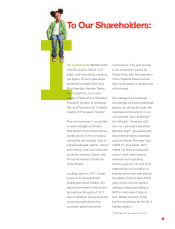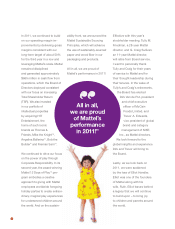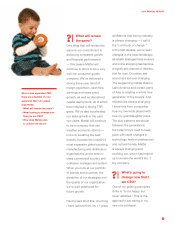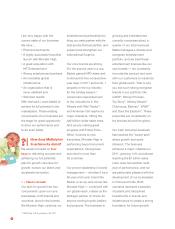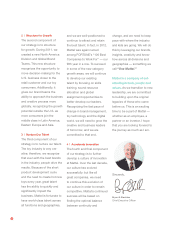Mattel 2011 Annual Report Download - page 15
Download and view the complete annual report
Please find page 15 of the 2011 Mattel annual report below. You can navigate through the pages in the report by either clicking on the pages listed below, or by using the keyword search tool below to find specific information within the annual report.PART I
Item 1. Business.
Mattel, Inc. (“Mattel”) designs, manufactures, and markets a broad variety of toy products worldwide which
are sold to its customers and directly to consumers. Mattel’s vision is “creating the future of play.” Mattel’s
objectives are to grow its share in the marketplace, sustain gross margins of about 50%, leverage its scale to
deliver cost savings and lower its selling and administrative costs, and create long-term stockholder value. To
achieve these objectives, management has established the following strategies:
The first strategy is to deliver consistent growth by continuing the momentum in its core brands, optimizing
entertainment partnerships, building new franchises, and working to expand and leverage its international
footprint.
The second strategy is to optimize operating margins through sustaining gross margins of about 50% and
delivering on cost savings initiatives.
The third strategy is to generate significant cash flow and continue its disciplined, opportunistic, and value-
enhancing deployment.
Mattel believes its products are among the most widely recognized toy products in the world. Mattel’s
portfolio of brands and products are grouped in the following categories:
Mattel Girls & Boys Brands—including Barbie®fashion dolls and accessories (“Barbie®”), Polly Pocket®,
Little Mommy®, Disney Classics®, and Monster High®(collectively “Other Girls Brands”), Hot Wheels®,
Matchbox®, and Tyco R/C®vehicles and play sets (collectively “Wheels”), and CARS®, Radica®, Toy
Story®, Max Steel®, WWE®Wrestling, and Batman®, and games and puzzles (collectively
“Entertainment”).
Fisher-Price Brands—including Fisher-Price®, Little People®, BabyGear™, Imaginext®, and View-
Master®(collectively “Core Fisher-Price®”), Dora the Explorer®, Go Diego Go!®, Thomas and Friends®,
Mickey Mouse®Clubhouse, Sing-a-ma-jigs®, and See ‘N Say®(collectively “Fisher-Price®Friends”), and
Power Wheels®.
American Girl Brands—including My American Girl®, the historical collection, and Bitty Baby®. American
Girl Brands products are sold directly to consumers via its catalogue, website, and proprietary retail stores.
Its children’s publications are also sold to certain retailers.
Mattel was incorporated in California in 1948 and reincorporated in Delaware in 1968. Its executive offices
are located at 333 Continental Blvd., El Segundo, California 90245-5012, telephone number (310) 252-2000.
Business Segments
“Mattel” refers to Mattel, Inc. and its subsidiaries as a whole, unless the context requires otherwise. This
narrative discussion applies to all segments except where otherwise stated. Mattel’s reportable segments are
separately managed business units and are divided on a geographic basis between domestic and international.
The Domestic segment is further divided into Mattel Girls & Boys Brands US, Fisher-Price Brands US, and
American Girl Brands.
For additional information on Mattel’s operating segment reporting, including revenues, segment income,
and assets, see Item 7 “Management’s Discussion and Analysis of Financial Condition and Results of
Operations—Results of Operations—Operating Segment Results” and Item 8 “Financial Statements and
Supplementary Data—Note 14 to the Consolidated Financial Statements—Segment Information.” For additional
information regarding geographic areas, see Item 8 “Financial Statements and Supplementary Data—Note 14 to
3


